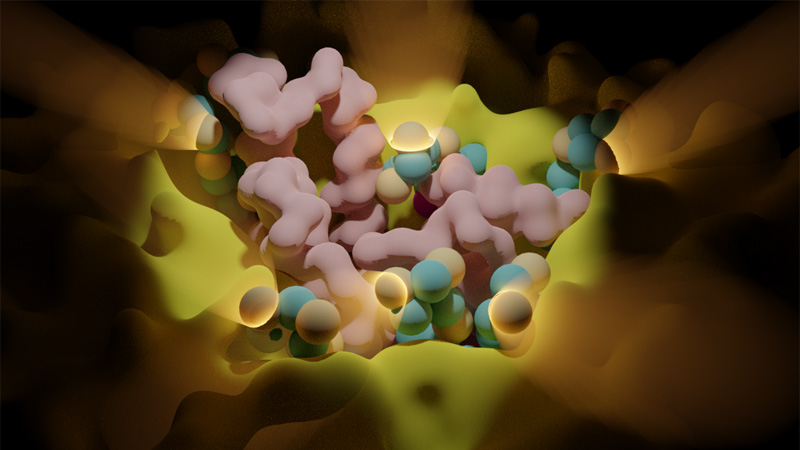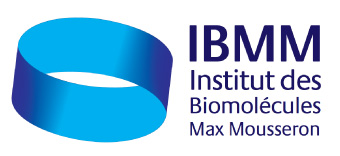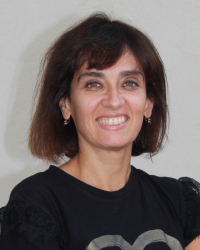The activities of the Pharmacology group can be divided into two distinct areas corresponding to the biological systems studied, namely G protein-coupled receptors (GPCRs) and kinases.

Our Themes
GPCR pharmacology
GPCRs are a large class of receptors that interact with many different ligands, including many of the molecules synthesized at IBMM (nucleotides, lipids, peptides, proteins…). As such, they are important conduits that transmit extracellular signals to downstream intracellular pathways, and are therefore important therapeutic targets with applications in most clinical areas. Therefore, understanding the mechanism of action of these receptors is not only an important fundamental endeavor but also a central mission for the pharmaceutical industry. However, this understanding is hampered by the fact that GPCR signaling is a complex process. In this context, our programs aim to elucidate this process. To this end, we are developing a cross multidisciplinary strategy that combines molecular information (axes 1,2) with cellular and physiological integration (axes 3,4) with a specific GPCR, the ghrelin receptor GHSR. Ghrelin is a circulating peptide hormone that plays a central role in physiology by regulating food intake, energy expenditure, insulin secretion, reward-seeking behavior, and gastric motility, among others. As such, the ghrelinergic system is a target for pharmacological intervention in the treatment of obesity, metabolic disorders or addiction to alcohol and drugs of abuse, all major public health problems. Thus, we expect that our work will shed light on how GPCR-mediated processes, which is a central question in biology. In addition, progress toward such understanding will pave the way for the design of original drugs that will target the ghrelinergic system, which is a key issue for the pharmaceutical industry, but still a daunting challenge.
Axis 1. Molecular dynamics
Axis 2. Molecular bases of GPCR signaling. We aim here at illuminating the molecular mechanisms underlying ghrelin receptor-mediated signaling. Almost every facet of GPCR function is connected with its dynamics. Indeed, essentially all aspects of pharmacology – ligand binding, receptor activation, biased agonism, coupling to signaling partners, allosteric regulation – are inherently dynamic phenomena. Our program thus intends at deciphering these dynamics using a palette of in vitro model systems of increasing complexity and state-of-the art biophysical methods. Namely, we use a combination of expression systems based on bacteria, insect- and mammal cells to produce the ghrelin receptor as a recombinant protein which is then inserted into model systems mimicking the membrane (lipid nanodiscs, liposomes). Thanks to these in vitro systems, we can explore the receptor conformational dynamics and the influence of the environment – lipids, dimerization partners, signaling proteins – using a combination of state-of-the-art biophysical methods – solution state NMR, fluorescence, X-ray scattering – adapted to these dynamics. In combination with the outputs from axes 1, 3 and 4, we expect to get a direct description of the relationship between the chemical structure of the ligand, its impact on the receptor structure, and the coupling to signaling partners.
Axis 3. Exploration of GPCR signaling in cells. We aim to understand the mechanisms underlying the function of GPCRs in a cellular context with a special interest in the ghrelin receptor GHSR. GPCRs are dynamic proteins oscillating between different conformations that interact differently with their ligands and effectors. In cells, multiple receptors exploring various conformation lead altogether to a global intracellular response. It is influenced by several parameters including the pattern of expression of the different proteins involved, the oligomerization or the ligands among others. Naturally occurring mutations are reported for GPCRs sometimes leading to receptors with different behaviors in terms of conformational dynamics resulting in an altered signaling profile that may be linked to a pathology. Using a combination of cellular pharmacology (binding, second messenger quantification) and biophysical (fluorescence, FRET, BRET…) approaches we explore the signaling and cellular fate of receptors and pathology-related mutants in cell models. Together with the knowledge gained from molecular dynamics approaches (axis 1) and from experiments performed in a controlled environment (axis 2) our research contributes to better understand the molecular mechanisms and the signaling events occurring during GPCR activation and the consequences of mutations.
Biosensors and kinase inhibitors
KEYWORDS : Kinase, Cancer, Fluorescent Biosensor, Allosteric Inhibitors, Peptides
INTRODUCTION – Cyclin-dependent Kinases & Cancer
One of the hallmarks of cancer concerns the deregulation of cell proliferation mechanisms, associated with gene amplification, overexpression or hyperactivation of protein kinases (PKs), which constitute established biomarkers of cell proliferation, as well as attractive pharmacological targets for the development of targeted therapies.
FLUORESCENT PEPTIDE BIOSENSORS:
With the aim of proposing sensitive and selective strategies for the detection of PKs, we have developed an original technology based on fluorescent peptide biosensors
ALLOSTERIC TARGETING of PKs:
With the aim of proposing new PK inhibitors for targeted, selective and effective anticancer therapies, we have developed two strategies 1- The design and rational development of peptide and peptidomimetic inhibitors targeting essential interfaces involved in PK activation 2- High-throughput screening of chemical libraries of small molecules targeting protein/protein interfaces or essential conformational changes
Our research projects focus on:
(1) The development of a “toolbox” of fluorescent peptide biosensors for the detection and quantification of kinase activities which constitute relevant enzymatic biomarkers in complex samples (cell lysates or human biopsies)
(2) The implementation of a multisensing / multiplexing strategy through combination of several fluorescent biosensors, for the simultaneous detection of several CDK activities in a single sample, enabling “profiling” of specific signatures in biopsies from patients with cancer
(3) The development of “nanobiosensors” through conjugation of peptide biosensors onto carbon nanotubes (CNTs) which constitute sensitive biosensing platforms for in vitro applications and for in vivo imaging in mice.
(4) The design of a hybrid biosensing strategy by combining peptide biosensors with polycarbonate microneedles for the sampling and detection of skin biomarkers
(5) Rational targeting of protein interfaces involved in PK activation using peptide inhibitors
(6) Identification and optimization of allosteric kinase inhibitors thanks to an original conformational biosensor technology implemented to screen chemical compound libraries
CURRENT FUNDING OF ONGOING PROJECTS
PCSI AVIESAN/INSERM ITMO Cancer project (interdisciplinary physics/chemistry for cancer) “CDK5ALLOCANCER: Identification of allosteric inhibitors targeting CDK5 kinase using orthogonal conformational biosensors” (Nov 2021-Nov 2024, Collab F.Bihel & M.Tramier)
MUSE Master2 Labex Chemistry grant “MELANOKIN: Targeting CDK4 and CDK5 kinases by combinations of orthosteric and allosteric inhibitors in ex ovo melanoma models” (2024)
Regional League Against Cancer (2024) “Therapeutic targeting of pancreatic cancers by combination of orthosteric and allosteric inhibitors of CDKs Kinases”
CNRS Innovation: “BIOCAN: HYBRID CNT-FET-PEPTIDE BIOSENSORS FOR THE DETECTION OF CANCER BIOMARKERS” (2024-26 Collab S.Bernard & J.Claudel)








